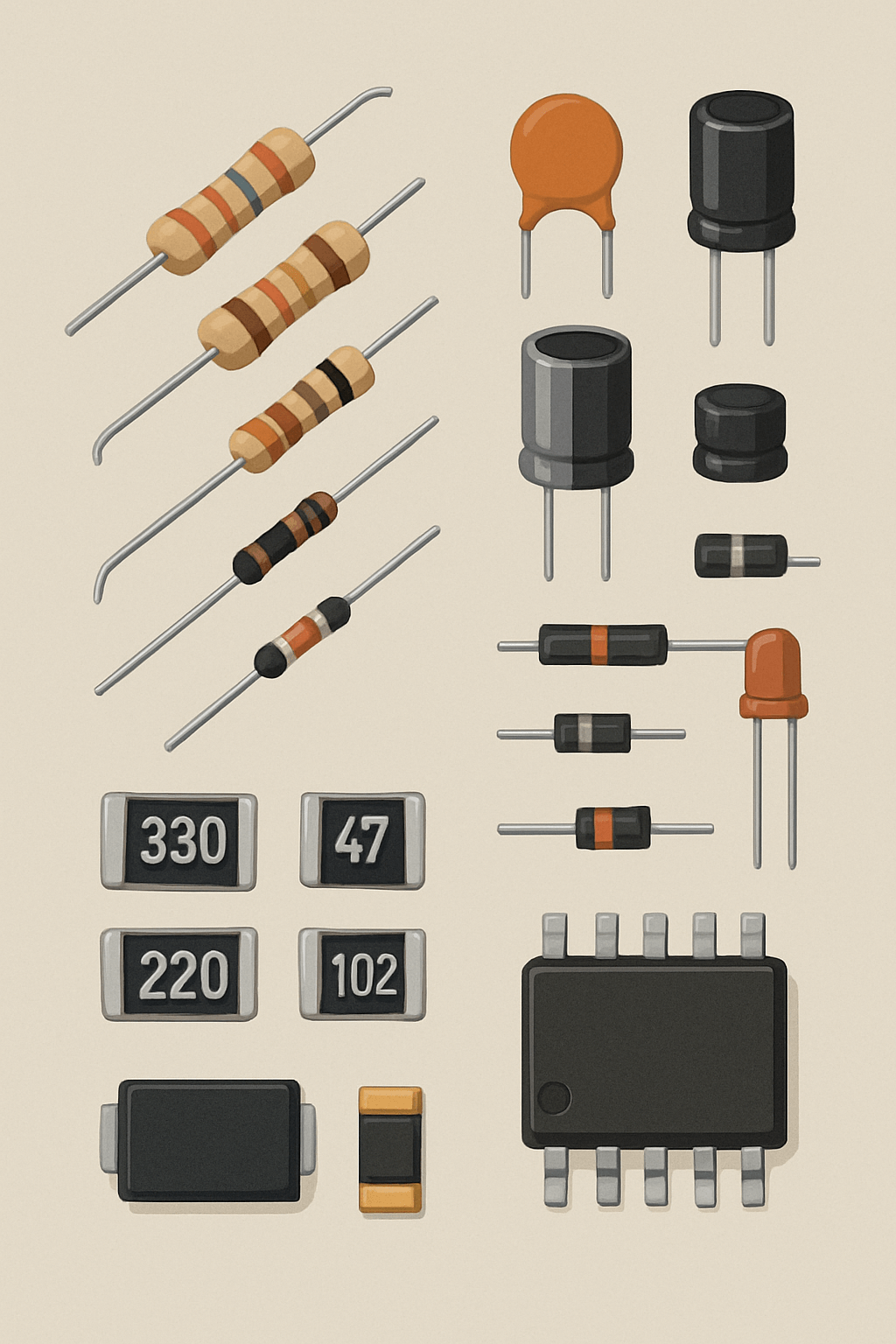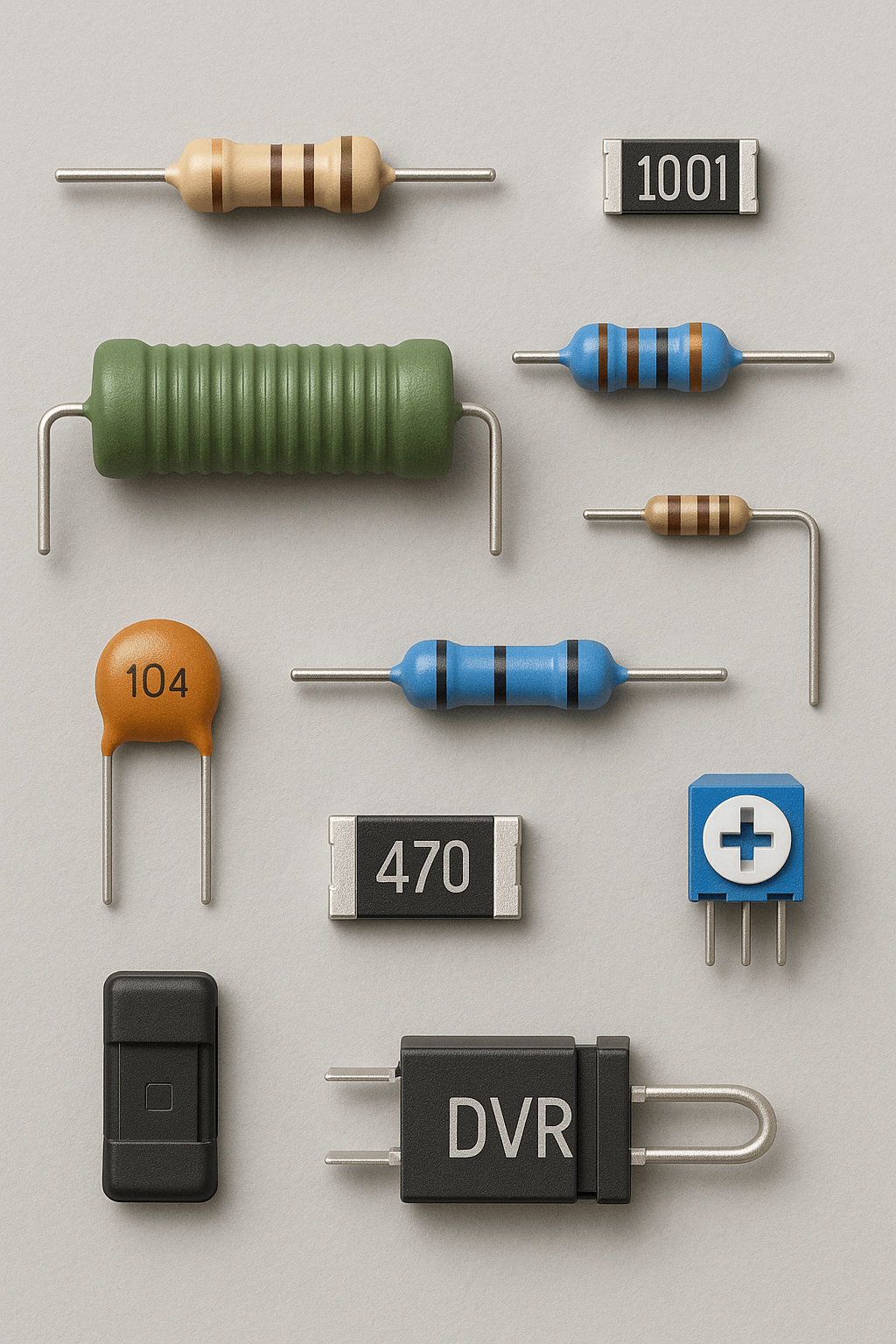Customs Clearance of Resistors (Carbon Composition, Film, Array, SMD, Wirewound)
Electronic resistors including carbon composition, film, array, SMD, and wirewound are critical components in electronic circuits, used across industries such as electronics, automotive, telecom, and medical equipment. Clearing these parts through customs requires full awareness of the tariff code (HS Code), required documentation, and customs-specific technical considerations.

For an estimate of the time and cost of clearing electronic resistors, contact the Saba Tarkhis experts.
Instant Free Consultation1) Detailed Description of Electronic Resistors
Resistors are among the most fundamental passive components in electronics, functioning in current limiting, voltage division, and shaping circuit response. In supply chain and clearance terms, they ship as SMD tape-and-reel, tube/tray, through-hole bulk (axial/radial), and sometimes array modules. Attributes such as tolerance (±1%, ±5%, ...), TCR, rated power (⅛W up to several watts), working voltage, and dimensional standard (e.g., 0402, 0603, 0805, 1206 in SMD) form the commercial/technical spec and must be reflected in shipping docs and COC/COA to ensure consistency with the declaration.
For customs, precise identification of resistor type (carbon composition, film, wirewound, array, general SMD or special-use like shunt/power) matters; it can impact HS Code, standards control, and even the need for conformity assessment certificates. Many POs arrive as by KPN/MPN with wide variety of ohmic values, power ratings, and packaging; in such cases a granular Packing List listing the Part Number and quantity of each item prevents valuation disputes and warehouse mismatches.
In practice, demand stems from automotive, smart appliances, telecom, power, and medical sectors. Tech cycles (e.g., IoT wave and power electronics) shift the resistor mix; for instance, growth of high-consumption equipment expands power wirewound usage, while gadgets drive small-size SMD demand. Logistically, resistors are typically non-dangerous but moisture/ESD sensitive; thus ESD-safe packaging, moisture barrier bags, and including a dry pack card are recommended.
For clearance, mind pricing units (per reel/per thousand pieces/per piece), correct declaration unit, and line-item segregation to avoid tariff disagreements. For large orders, manage SN/Batch Traceability to support quality tracking and after-sales services.
2) Types of Resistors and Their Applications
Carbon Composition Resistor: Made of carbon-based materials and known for withstanding high temperature and stress, widely used in industrial and harsh environments. Owing to lower cost, they are popular in general-purpose circuits and higher-power electrical devices.Film Resistor: A thin resistive layer deposited on a ceramic base. Their high accuracy and stability suit sensitive applications such as medical equipment and precision instruments.
Array/Network Resistor: Multiple resistors in a single package for compact circuitry needs. By saving space and cost, they are used in phones, laptops, and other electronics.
SMD Resistor: Surface-mount resistors are small and light, mounted directly on PCBs. They are used in compact, complex devices like smartphones and modern tech gear.
Wirewound Resistor: Constructed by winding a thin wire on a resistive core, ideal for high-voltage tolerance and high accuracy applications. Used in protection circuits and high-voltage devices.
3) Key Points for Resistor Clearance
- Place the order with a precise technical description (type, power, tolerance, size code, packaging: reel/tube/bulk).
- Match Invoice and Packing List to MPN/PN and quantities; state the declaration unit (PCS/ROLL/THOUSAND PCS).
- Align the HS Code with the exact product type (see table) to avoid tariff disputes.
- Configure cargo as ESD-safe and ensure dry, moisture-free storage at entry points.
- For mixed consignments, separate lines by type/power/application to facilitate appraisal.
4) Tariff and HS Code
Electronic resistors fall under tariff heading 8533. Depending on specific types, subheadings may vary. To ensure correct classification, use up-to-date customs systems and consult professional brokers.
| Resistor Type | Short Description | HS Code |
|---|---|---|
| Carbon Composition | General-purpose/higher power | 8533.10.10 |
| Film | High stability & accuracy | 8533.10.20 |
| Array/Network | Multiple resistors in one package | 8533.10.30 |
| SMD (Surface Mount) | SMT, sizes 0402/0603/0805/... | 8533.10.40 |
| Wirewound | High power/voltage, precision | 8533.21.00 |
Exact subheading may vary with tolerance, power, packaging, and end-use.
5) Special Conditions for Import & Export of Resistors
Electronic resistors, as vital components across electronics, telecom, automotive, and medical industries, are produced and consumed in large quantities worldwide. Imports into Iran—particularly from advanced electronics manufacturing countries—are crucial due to broad domestic usage.
Imports to Iran
Most electronic resistor imports to Iran come from China, South Korea, Japan, and Germany. These countries are major global producers of electronic components and supply up-to-date, high-quality products. China, due to lower costs and mass production, is a key supplier; South Korea and Japan, thanks to high quality and innovation, also hold significant shares in Iran.
Exports from Iran
Iran exports resistors to neighboring countries—especially Iraq, Afghanistan, and some GCC markets—that rely on importing electronic parts. However, export volumes are much lower than imports, as most domestic production serves local industries.
6) Iran Market
- Main consumers: PCB assemblers, automakers, appliance manufacturers, and the repair ecosystem.
- Common sources: China (variety & price), Korea/Japan/Germany (quality & stability).
- Practical tip: plan inventory for high-rotation SMD sizes (0603/0805) and power wirewounds.
7) Import & Export Volumes
In recent years, imports of electronic resistors to Iran have grown notably with the expansion of new technologies and the electronics sector. China and South Korea account for the largest shares. According to customs data, imports of electronic resistors reach several hundred million USD annually, and the trend is rising as cross-industry usage expands.
Conversely, Iran’s exports are much smaller and mainly target neighboring countries, since domestic demand and limited global-scale competitiveness constrain export potential.
8) Global Market
The global resistor industry moves several billion dollars annually. China dominates production and exports; South Korea, Japan, Germany, and the United States are also major producers.
On the import side, economies with advanced electronics industries and demand for precision components—such as the US, EU, India, and Brazil—are among the largest importers.
9) Required Documents for Clearance
- Invoice:
A primary document detailing the purchased goods—quantities, unit price, and total price—issued formally by the seller and matching the arriving cargo.
Packing List:
Shows packaging details: number of packages, net/gross weights, and general packaging specs (dimensions and type). Customs use it to verify shipment contents.
Certificate of Origin:
Indicates the exporting country, usually issued by the local Chamber of Commerce, and is used for tariff preferences where applicable.
Bill of Lading:
Issued by the carrier, describing the mode and terms of transport from origin to destination; also serves as a document of title.
Standard Certification:
Some resistors may require quality/safety approvals. In Iran this is typically from the National Standards Organization.
Order Registration Permit:
For imports into Iran, obtain the MOI (Industry/Mine/Trade) order registration permit, confirming compliance with trade regulations.
Customs Declaration Form:
Provides complete information on goods and technical details; filed by the owner or customs broker.
Inspection Certificate:
In some cases, customs may require third-party inspection to verify compliance with declared specifications.
10) Clearance Method: Fast, Simple, Accurate
- Pre-checks: determine HS by type, power/tolerance, packaging, and part list.
- Order registration and permits (where applicable: national standards for some groups).
- Arrange freight, prepare docs (Invoice/PL/BL/CO), and ensure ESD/moisture control at inbound warehouses.
- Declare goods, complete appraisal formalities, and pay duties/taxes.
- Final release and delivery; plan distribution and batch traceability for after-sales.
Key Tips & Practical Advice
- Before purchase, align MPN and specs (tolerance/power/size) across PO and shipping docs.
- For assorted shipments, provide a detailed Packing List splitting every line item.
- For SMD consignments, enforce ESD-safe packaging and moisture control.
- Start with HS 8533 and refine by type (carbon/film/array/SMD/wirewound) for accurate classification.
- Leverage Saba Tarkhis for permits, documentation, and faster procedures.

FAQs
What is the HS Code for electronic resistors?
Generally classified under chapter 8533; examples: carbon 8533.10.10, film 8533.10.20, array 8533.10.30, SMD 8533.10.40, and wirewound 8533.21.00.
Which documents are required for clearance?
Invoice, Packing List, Bill of Lading, Certificate of Origin, standard certificate (where applicable), order registration permit, customs declaration, and inspection certificate (if requested).
What are Iran’s main import sources?
China (variety and price), South Korea and Japan (high quality), and Germany. Iranian exports mainly go to Iraq, Afghanistan, and some Gulf countries.
How can we avoid appraisal delays?
Ensure accurate HS, a detailed PL with MPN/PN, correct declaration units, and consistent shipping docs; arrange ESD packaging and dry storage conditions in advance.
Saba Brokerage Special Clearance Services
- Saba Brokerage, as a specialized customs broker, delivers end-to-end services for clearing electronic resistors and other components. Services include:
Specialized consulting: Experienced experts guide every customs stage and advise on optimal clearance methods and correct tariff codes.
Expedited clearance: With deep regulatory knowledge and strong connections, the team accelerates the process with minimal lead time.
Document management: All required paperwork is reviewed and completed meticulously to prevent delays.
Coordination with authorities: Strong ties with relevant bodies facilitate rapid permitting and legal steps.
Post-clearance services: Transport and final delivery after release are handled and tracked through to completion.
By partnering with this brokerage, importers can be confident all clearance steps are completed professionally, quickly, and in compliance with legal standards.
.png)
